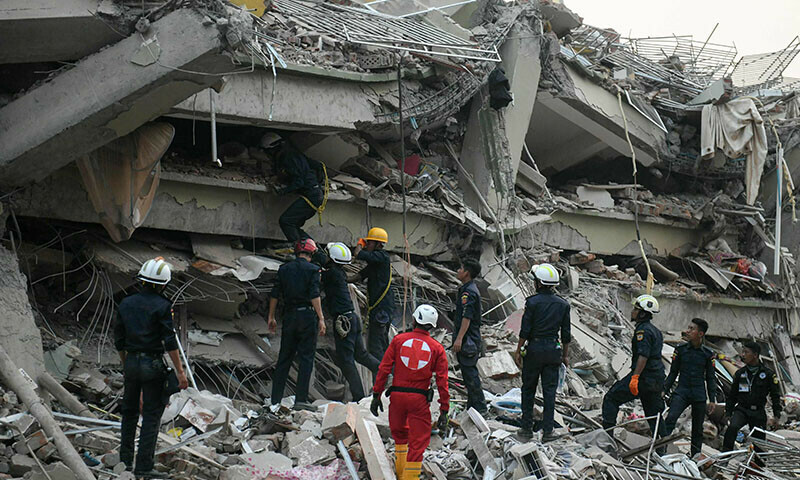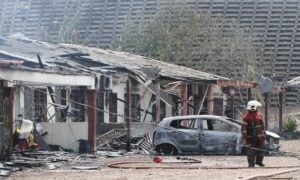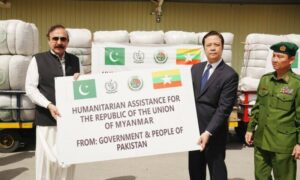The death toll from a huge earthquake that hit Myanmar and Thailand reached 1,644 on Saturday, according to a statement from the ruling junta.
The shallow 7.7-magnitude quake struck northwest of the city of Sagaing in central Myanmar in the early afternoon, followed minutes later by a 6.7-magnitude aftershock.
The quake destroyed buildings, downed bridges, and buckled roads across swathes of Myanmar, with massive destruction seen in Mandalay, the country’s second biggest city and home to more than 1.7 million people.
The death toll from the quake has risen to 1,644, the ruling junta said in a statement from their information team, with 3,408 people injured. The statement added that at least 139 people are still missing after Friday’s quake.
Around 10 more deaths have been confirmed in Bangkok.
But with communications badly disrupted, the true scale of the disaster has yet to emerge from the isolated military-ruled state, and the toll is expected to rise significantly.
It was the biggest quake to hit Myanmar in over a century, according to US geologists, and the tremors were powerful enough to severely damage buildings across Bangkok, hundreds of kilometres away from the epicentre.
In Mandalay, AFP journalists saw a centuries-old Buddhist pagoda that had been reduced to rubble by the quake.
“It started shaking, then it started getting serious,” said a soldier at a checkpoint on the road outside the pagoda.
“The monastery also collapsed. One monk died. Some people were injured, we pulled out some people and took them to the hospital.”
The head of the main Buddha statue in the monastery fell off and was placed on the platform at its feet.
“Everyone at the monastery dares not sleep inside, as we heard there could be another earthquake. I have never felt anything like this in my life,” said the soldier.
Guards at Mandalay Airport turned away journalists. “It has been closed since yesterday,” said one. “The ceiling collapsed but no one was hurt.”
Damage to the airport would complicate relief efforts in a country whose rescue services and healthcare system have already been ravaged by four years of civil war sparked by a military coup in 2021.
Rare junta plea for help
Junta chief Min Aung Hlaing issued an exceptionally rare appeal for international aid on Friday, indicating the severity of the calamity. Previous military regimes have shunned foreign assistance even after major natural disasters.
The country declared a state of emergency across the six worst-affected regions after the quake, and at one major hospital in the capital, Naypyidaw, medics were forced to treat the wounded in the open air.
One official described it as a “mass casualty area”.
“I haven’t seen [something] like this before. We are trying to handle the situation. I’m so exhausted now,” a doctor told AFP.
Mandalay, a city of more than 1.7 million people, appeared to have been badly hit. AFP photos showed dozens of buildings reduced to rubble.
A resident reached by phone told AFP that a hospital and a hotel had been destroyed, and said the city was badly lacking in rescue personnel.
A huge queue of buses and lorries lined up at a checkpoint to enter the capital early on Saturday.
Offers of foreign assistance began coming in, with President Donald Trump on Friday pledging US help.
“It’s terrible,” Trump told reporters in the Oval Office about the quake when asked if he would respond to the appeal by Myanmar’s military rulers.
“It’s a real bad one, and we will be helping. We’ve already spoken with the country.”
An initial flight from India carrying hygiene kits, blankets, food parcels and other essentials landed in the commercial capital Yangon on Saturday.
“We will continue to monitor the developments and more aid will follow,” said Indian Foreign Minister Subrahmanyam Jaishankar.
China said it sent an 82-person team of rescuers to Myanmar.
Russia, Malaysia and Singapore were also sending planeloads of relief supplies and personnel to Myanmar, which has been ravaged by a civil war after a 2021 military coup ousted an elected civilian government.
South Korea said it would provide an initial $2 million in humanitarian aid to Myanmar through international organisations.
Aid agencies have warned that Myanmar is totally unprepared to deal with a disaster of this magnitude. Some 3.5m people were displaced by the raging civil war, many at risk of hunger, even before the quake struck.
Bangkok building collapse
Across the border in Bangkok, rescuers worked through the night searching for survivors trapped when a 30-storey skyscraper under construction collapsed, reduced in seconds to a pile of rubble and twisted metal by the force of the shaking.
Bangkok governor Chadchart Sittipunt told AFP that around 10 people had been confirmed killed across the city, most in the skyscraper collapse.
But up to 100 workers were still unaccounted for at the building, close to the Chatuchak weekend market that is a magnet for tourists.
“We are doing our best with the resources we have because every life matters,” Chadchart told reporters at the scene.
“Our priority is acting as quickly as possible to save them all.”
Bangkok city authorities said they would deploy more than 100 engineers to inspect buildings for safety after receiving over 2,000 reports of damage.
Up to 400 people were forced to spend the night in the open air in city parks as their homes were not safe to return to, Chadchart said.
Significant quakes are extremely rare in Bangkok, and Friday’s tremors sent shoppers and workers rushing into the street in alarm across the city.
While there was no widespread destruction, the shaking brought some dramatic images of rooftop swimming pools sloshing their contents down the side of many of the city’s towering apartment blocks and hotels.
Even hospitals were evacuated, with one woman delivering her baby outdoors after being moved from a hospital building. A surgeon also continued to operate on a patient after evacuating, completing the operation outside, a spokesman told AFP.
Myanmar quake struck mosques as Muslims gathered for Ramazan prayers
When Friday’s powerful earthquake struck central Myanmar, Htet Min Oo was performing ablution before Ramazan prayers at a mosque next to his house in Mandalay.
His home collapsed along with part of the mosque, trapping half his body with the rubble of a wall that buried two of his aunts. Residents raced to pull the aunts out, he said, but only one survived.
Htet Min Oo, 25, said two uncles and his grandmother were also trapped under piles of concrete.
With no heavy equipment available, he tried desperately to clear the rubble with his hands but could not shift it.
“I don’t know if they are still alive under the debris. After so long, I don’t think there’s any hope,” he said on Friday.
“There’s too much rubble and no rescue teams have come for us,” he added, his voice shaking as he broke into tears. Hundreds of Muslims are feared among the dead in Myanmar after the shallow quake struck as worshippers gathered at mosques for Friday prayers in the holy month.
More than 50 mosques sustained damage, according to the shadow National Unity Government.
A 39-year-old resident of the Mandalay region described harrowing scenes as he tried to save a man trapped under the debris of a collapsed mosque in Sule Kone village, but had to flee because of strong aftershocks.
“I had to leave him behind … I went in a second time to try to save him,” he said, declining to be identified.
“I retrieved four people with my own hands. But unfortunately, three were already dead and one died in my arms.”
He said 10 people had been killed there, and that they were among 23 who died at three mosques that were destroyed in the village. Government restrictions had prevented them from being upgraded, he said.
Muslims are a minority in predominantly Buddhist Myanmar and have been marginalised by successive governments, while ultranationalist groups and extremist monks have in recent years incited violence.
Myanmar authorities have for decades made it difficult for Muslims to obtain permission to repair or build new mosques, according to a 2017 report by the US State Department, which said historic mosques have deteriorated because routine maintenance was denied.
Buddhist buildings were also badly hit by the quake, with 670 monasteries and 290 pagodas damaged, according to the military government. It did not mention any mosques in its damage report.
Reuters could not reach the mosques or verify the accounts of the collapses.
One man, Julian Kyle, appealed on social media for heavy equipment to lift concrete pillars after the quake destroyed another Mandalay mosque.
“Underneath the rubble, my family members and others were crushed and lost their lives,” he posted. “We desperately want to recover their bodies.”
A resident from the town of Taungnoo about 370km away said he was praying when one side of the Kandaw mosque caved in on two rows of men seated before him.
“I saw so many people carried out from the mosque, some of them died right before my eyes,” he said. “It was truly heartbreaking.”










